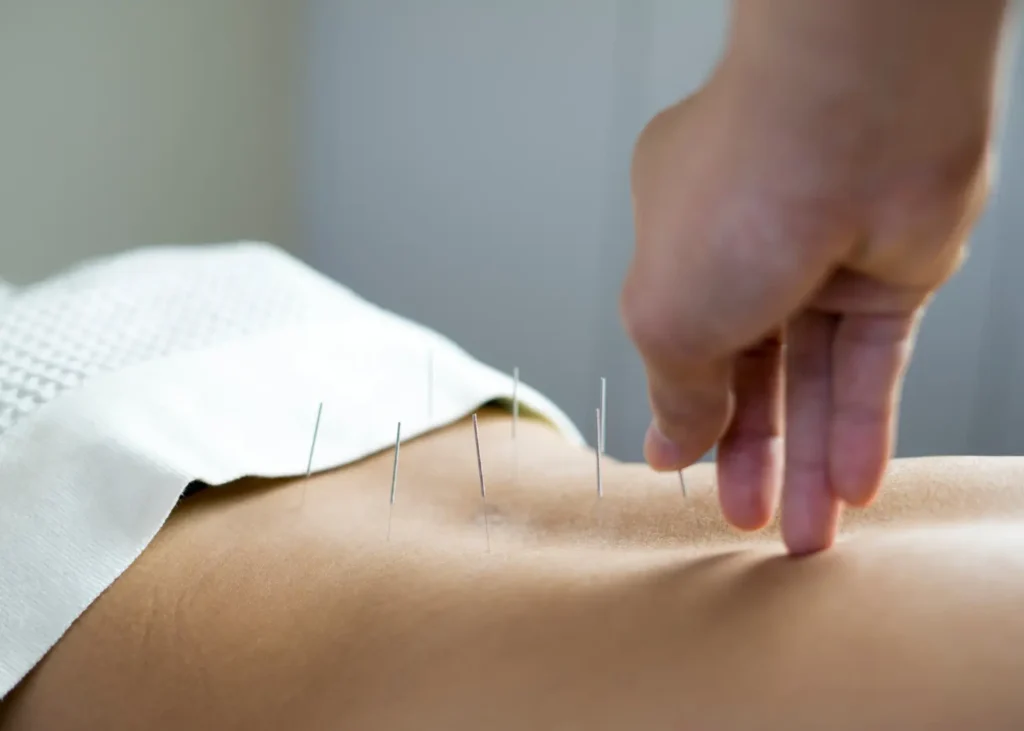Traditional Chinese Medicine (TCM) teaches that acupuncture works through a network of energy channels known as the acupuncture meridian system. These meridians are believed to carry life energy (Qi) throughout the body, forming an interconnected web that links organs and tissues. In modern medical acupuncture practice, understanding this meridian network is crucial for both traditional healing and bridging ancient concepts with contemporary science. In this article, we take a look at what meridians are, their function in acupuncture and meridian theory, and their application in contemporary clinical settings.
Understanding the Acupuncture Meridian System
At the heart of acupuncture is the concept of Qi (vital energy) flowing through defined pathways. In TCM theory, Qi energy flow travels along meridians that cover the body in a precise map. According to classical teaching, there are 12 primary meridians corresponding to organ systems, plus additional vessels that interconnect these main channels. Through these pathways, Qi circulates to maintain balance and health. If the energy flow is smooth and balanced, the body is in a state of wellness; if it becomes blocked or unbalanced, illness can result. Each meridian is associated with specific functions and organ relationships. For example, the Heart meridian influences cardiovascular and emotional health, while the Liver meridian affects detoxification and stress. The TMC meridian model encompasses the entire body, providing a holistic view of how different parts of the organism are energetically linked.
Commonly Used Acupuncture Points and Treatments
Crucially, meridians also serve as the roadmap for acupuncture points. There are hundreds of acupuncture points (over 2,000 in some traditions) arranged along these meridian lines. Four commonly utilized acupuncture points are accompanied by typical treatments and insights into how practitioners select and apply them. By stimulating a point on a meridian, practitioners aim to influence the flow of energy not only at that local area but throughout the channel and related organ system. This is why the acupuncture energy meridians concept is so integral: it explains how a needle in the foot might treat a headache, or why an acupuncturist might needle the hand to alleviate lung congestion.
Mapping the TMC Body Map: Meridians of the Human Body

The classical meridian map divides the body into twelve principal channels plus several collateral ones. As mentioned, each of the 12 primary Chinese acupuncture meridians is associated with an internal organ and runs along one side of the body, typically originating or terminating at the hands or feet. From those extremities, each meridian travels either up or down, connecting through the torso or head and linking with its related organ. The lung acupuncture meridian (the Lung channel) begins in the chest, travels down the inner aspect of the arm, and ends at the thumb. In contrast, its paired Large Intestine meridian starts at the index finger and runs up the arm to the face. In this way, every limb and region is covered by some meridian pathway.
Organ naming can be somewhat symbolic, but the naming reflects the primary organ each channel is said to support. All together, the body’s meridian network is comprehensive: TCM literature describes twelve standard meridians linked to organs (such as Lung, Heart, Kidney, etc.) plus eight extraordinary meridians that act as reservoirs or crossover channels. Understanding the layout of meridians is fundamental for practitioners. During training, acupuncturists memorize detailed anatomical trajectories for each channel. The course of the Gallbladder meridian zigzags from the side of the head down the lateral aspect of the body to the fourth toe, while the Spleen meridian runs from the big toe up the inner leg into the abdomen. Because meridians often flow through regions far from their namesake organ, symptoms can appear distal to the actual issue. An imbalance in the Liver meridian might manifest as eye problems or migraines, and treating points on that meridian can provide relief.
Meridians in TCM Practice: A Holistic Approach
In TCM, an upset stomach might not simply be a gastrointestinal issue; it could reflect disharmony in the Spleen and Stomach meridians. A holistic evaluation is made by considering the patient’s entire life context, including diet, emotions, environment, and habits, which are all thought to influence Qi. The meridian system is part of a non-reductive model of health – rather than pinpointing a single cause, it assesses how a person’s energy became unbalanced and aims to correct it. In practice, this means the acupuncturist might give lifestyle advice alongside performing acupuncture to address the root of the imbalance.
When a patient visits an acupuncturist, the practitioner will typically perform a detailed intake that includes questions about various symptoms and life factors, feeling the pulses at the wrist, and observing the tongue. Using this information, the acupuncturist identifies which meridians are too “hot” or “cold,” too full or too empty, or otherwise not in harmony. A diagnosis might be phrased as something like “Liver Qi stagnation” or “Spleen Qi deficiency,” indicating which meridian’s energy is at fault and in what way. The treatment is then tailored to that diagnosis: points along the specific meridians will be chosen to either disperse stagnation or tonify deficiency, etc.
Because of this paradigm, treatment plans in TCM are highly individualized. Three different patients with knee pain could receive three different treatments depending on their meridian diagnoses. One patient’s knee pain might come from a cold blockage in the Kidney meridian, another from dampness affecting the Liver/Gallbladder meridian, and another from general Qi stagnation. The acupuncture points selected for each would differ accordingly. This illustrates how acupuncture and meridian knowledge are applied as both art and science in the clinic. It requires interpreting the body’s signals through the meridian lens and crafting a response that restores balance specifically for that person. The meridians provide a framework that connects symptoms in one area to disturbances in another, enabling a truly integrative form of diagnosis and therapy.
In modern integrative clinics such as Mod Meds and other forward-thinking wellness centers, practitioners often blend this TCM meridian approach with conventional medical insights. They may practice what could be termed clinical acupuncture, where they uphold the traditional methods of meridian diagnosis and point selection, but also take into account biomedical information. The result is a comprehensive care plan that utilizes acupuncture to rebalance nerve meridians and alleviate symptoms, while also addressing any anatomical issues or disease processes identified by Western medicine.
Educational Resources on Acupuncture
For those interested in exploring acupuncture and its foundational concepts, such as meridians and point charts, a variety of educational programs and resources are available. Many accredited institutions offer comprehensive degree programs, such as a Master of Acupuncture Studies or Doctor of Acupuncture, which delve deeply into both the theoretical and practical aspects of Traditional Chinese Medicine (TCM). These programs typically include rigorous coursework on the meridian system, acupuncture point locations, and the philosophy behind Qi flow, alongside hands-on clinical training. For individuals seeking a more introductory approach, workshops, online courses, and certificate programs are widely accessible. These resources often provide interactive meridian charts, video demonstrations, and detailed guides to help learners visualize and understand the pathways and functions of the body’s energy channels.
Finding the Top Acupuncture Clinics and Booking Sessions

If you’re interested in experiencing acupuncture and the healing potential of meridians, the next step is to find a qualified practitioner or clinic. The good news is that acupuncture has become widely available, from dedicated TCM clinics to integrative medical centers. When searching for top acupuncture clinics, consider the following tips:
- Credentials and Experience: Ensure the acupuncturist is licensed and has substantial experience. Top clinics will proudly share the credentials of their practitioners and often have specialists for specific conditions. Experienced providers have a deep understanding of the meridian system and can formulate effective, personalized treatments.
- Holistic Consultation: A quality clinic will offer a thorough initial consultation, reflecting the TCM holistic approach. Expect them to ask about your medical history, lifestyle, and any specific symptoms you are experiencing. This is a sign that the practitioner is diagnosing which meridians may need attention rather than giving a one-size-fits-all treatment. The best clinics blend meridians in TCM practice knowledge with modern insights to tailor the therapy.
- Safe and Clean Environment: Acupuncture involves skin penetration, so a top clinic must follow strict hygiene and safety protocols. Sterile single-use needles, clean treatment rooms, and proper patient monitoring are standard. (In the U.S., needles are regulated by the FDA as medical devices and must be used once and disposed of.) A reputable clinic prioritizes patient safety.
- Convenient Access and Booking: Many of the top clinics today embrace technology for patient convenience. Online acupuncture session booking is commonly offered, allowing you to schedule appointments through a website or app. This is not only convenient but also a sign of a professional, organized practice. When you get acupuncture treatment, you want the focus to be on healing, not on administrative hassles, so user-friendly booking and clear communication are a plus.
- Integrated Services: Some clinics provide additional therapies like herbal medicine, nutritional counseling, or massage (e.g., tuina or Shiatsu) as part of their service. These complementary offerings indicate a well-rounded approach to wellness. While not necessary for effective acupuncture, such services show that the clinic aims to treat the “whole person” – a philosophy aligned with meridian-based healing.
When evaluating options, don’t hesitate to ask questions. A brief phone call or consultation can give you a sense of the clinic’s approach. You might ask: “Do you specialize in any conditions?” or “How do you incorporate meridian diagnosis in your treatments?” Their answers will reveal their expertise and style. Trust and comfort are essential – acupuncture involves a therapeutic relationship and a process, so you want to choose a provider you feel at ease with.

Booking your first session is usually straightforward. After finding your chosen clinic, you can use their acupuncture session booking tool online or call their office. Initial visits often last longer (perhaps 60-90 minutes) to allow for diagnosis via meridian theory and discussion of your goals. Follow-up treatments might be shorter (30-60 minutes). Acupuncture is generally a gentle and relaxing experience – the needles are skinny, and treatments often include soft music or a calm environment to help you relax as your Qi balance is restored. Many people feel improvements after just a few sessions, though chronic conditions may require a series of treatments. By choosing a skilled practitioner and a respected clinic, you’re setting the stage for a positive healing journey with acupuncture. Whether you’re seeking pain relief, stress reduction, or help with a specific health issue, tapping into the wisdom of the meridian system through a qualified professional can be a profoundly beneficial step.
Meridians remain a cornerstone of how acupuncture is practiced, even as medical understanding evolves. The concept of an invisible energy network might have originated thousands of years ago, but its usefulness is proven daily in acupuncture clinics worldwide. By viewing the body as an interconnected system, practitioners can treat not just symptoms but root causes. The human body meridians provide a map for these connections, guiding acupuncturists where to place needles to stimulate healing responses. Modern research continues to shed light on possible physiological underpinnings of meridians, from nerve pathways to connective tissue planes, giving credence to the idea that these channels are more than metaphor. As you consider acupuncture for yourself, know that this ancient practice stands on a rich foundation of meridian theory, one that is continually validated by the positive outcomes in modern clinical acupuncture settings. With skilled practitioners who understand both the art and science of meridians, acupuncture can be a safe, effective complement to your healthcare, helping to unblock your pathways to better health.
Sources
- Medical News Today – “How does acupuncture work?” (Dec 7, 2023)medicalnewstoday.com
- Evidence-Based Complementary and Alternative Medicine (Journal, 2011) – Research article by Yu Bai et al. on fascia network as the anatomical basis for meridianspmc.ncbi.nlm.nih.gov
- Harvard Medical School – “Exploring the Science of Acupuncture” (News article, Nov 1, 2021)hms.harvard.edu